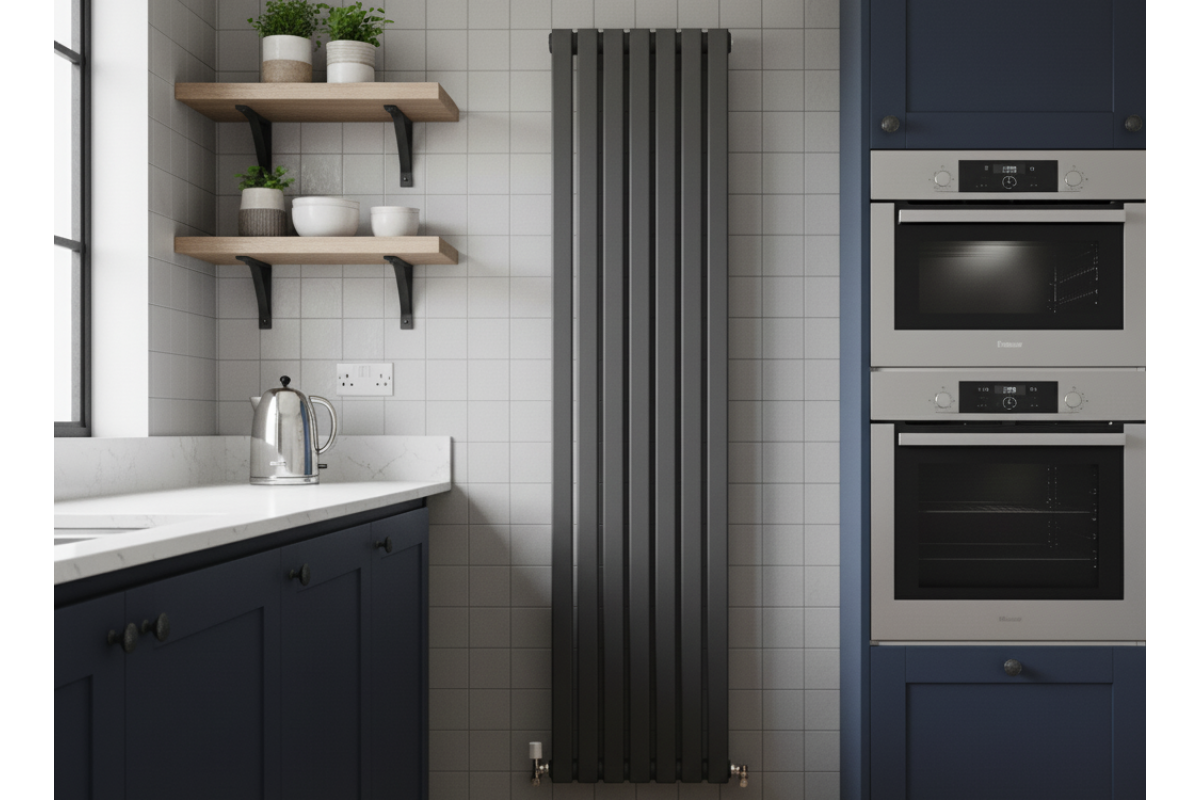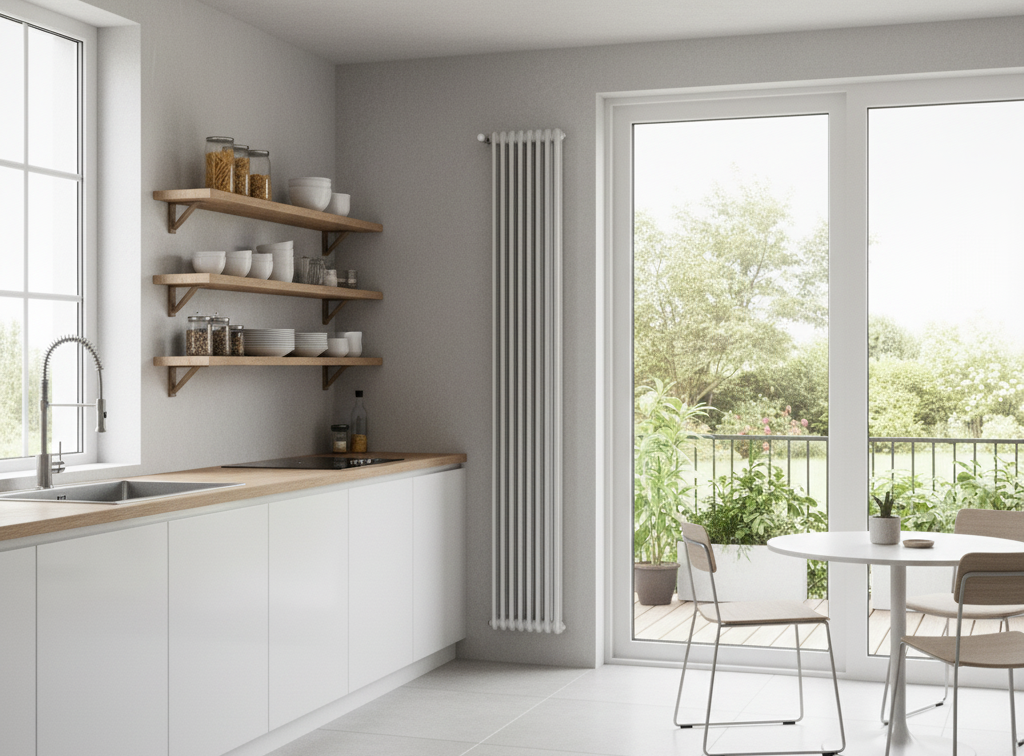Cost-Effective Kitchen Radiator Solutions

Introduction: The Heart of the Home Deserves Smarter Heating
The kitchen is often the heart of the home, but it presents a unique and difficult heating challenge. Many homeowners find it's the coldest room in winter, yet it can become uncomfortably hot while cooking. This problem arises from limited wall space, rapid temperature changes, and high humidity, which can make standard radiators inefficient and impractical. A conventional white panel radiator simply isn't designed for this dynamic environment.
This guide will show you how choosing the right electric radiator is the key to creating a comfortable, stylish, and energy-efficient kitchen. We'll look beyond the initial price to reveal what 'cost-effective' truly means in the long term, helping you make a smart, lasting investment. By understanding the specific demands of a kitchen, it becomes clear that a modern radiator is not a luxury, but the most practical and economical choice for this essential space.
Why Your Kitchen's Heating Needs Are Unique
To find the right heating solution, you first need to understand the specific constraints of a kitchen. These factors make it a completely different space to heat compared to a living room or bedroom.
Wall space in a kitchen is prime real estate, typically covered by cabinets, countertops, and appliances. This leaves very little room for the wide, horizontal radiators common in UK homes. Trying to fit one in often leads to a compromised layout or placing it in an inefficient spot, making space-saving solutions a necessity.
The kitchen is also a place of rapid temperature swings. Heat from ovens and hobs can raise the room's temperature quickly. A heating system needs to be responsive, warming up fast on a cold morning but also cooling down just as quickly when cooking starts to avoid wasting energy and overheating the room.
Finally, steam from cooking and dishwashers creates a humid atmosphere that can cause corrosion and rust on standard radiators. This can ruin their appearance and reduce their performance over time, making the choice of material incredibly important for longevity.
Decoding 'Cost-Effective': More Than Just the Price Tag
The term "cost-effective" is often mistaken for "cheap." For a long-term investment like a radiator, a truly cost-effective solution is one that provides the best value over its entire lifespan. This means shifting focus from the initial purchase price to the total cost of ownership.
While some modern radiators may have a higher upfront cost than basic models, this is only one part of the financial picture. A radiator's material directly impacts your energy bills. Materials with high thermal conductivity, like aluminium, heat up much faster than steel, meaning they use less energy from your boiler to reach the desired temperature. Over a radiator's 15-20 year lifespan, these savings add up significantly.
Furthermore, a durable, corrosion-resistant radiator made from a material like stainless steel is built to last in a humid kitchen, avoiding the cost and hassle of a premature replacement. Investing in quality **Designer Radiators** pays off through lower energy bills and a longer lifespan, helping you avoid the hidden costs of replacing a cheaper, less suitable model down the line.
The Material Matters: Choosing the Right Engine for Your Radiator
A radiator's material determines how it performs. It dictates its heat-up speed, energy efficiency, and resilience to the kitchen environment. Understanding the properties of each is key to making a cost-effective choice.
Aluminium: The Responsive Champion
Aluminium is a superconductor of heat, allowing it to warm a room much faster than other materials. This responsiveness is perfect for a kitchen's fluctuating temperatures, providing heat on demand and preventing overheating during cooking. Aluminium radiators are also lightweight, making them easy to install, and are highly efficient, using less hot water to produce the same heat output as steel.
Stainless Steel: The Durable Powerhouse
The main advantage of stainless steel is its exceptional resistance to rust and corrosion, making it the ideal material for a high-humidity kitchen. It requires very little maintenance and is built to last for decades, representing an excellent long-term investment. It also retains heat well and offers a premium, modern look.
Mild Steel: The Versatile All-Rounder
Mild steel is the most common radiator material, making it affordable and available in a vast range of styles and colours, including the popular anthracite finish. It offers a good balance between heat-up time and heat retention, providing reliable performance at a budget-friendly price.
The Space-Saving Champions: Vertical and Compact Radiators
To solve the kitchen's space problem, you need to think beyond the traditional horizontal panel. Modern radiators come in innovative forms designed to maximise both space and style.
Vertical Radiators: The Ultimate Space-Saver
By far the most practical choice for modern kitchens, vertical radiators use height instead of width. Their tall, slim profile allows them to be installed in narrow nooks or on short walls next to doorways, freeing up valuable horizontal space for cabinets and worktops. They also act as a striking design feature, adding a touch of contemporary elegance.

Kitchen Towel Rails: The Dual-Purpose Solution
A heated towel rail is an incredibly practical addition to a kitchen. It provides the perfect place to warm and dry tea towels and hand towels, which helps improve hygiene by preventing damp cloths from harbouring bacteria. Available in a huge range of styles, they can provide effective heating while adding functional luxury.
Column Radiators: A Touch of Classic Style
With a design dating back to the Victorian era, column radiators offer a timeless look that suits both traditional and contemporary kitchens. Their structure creates a large surface area, resulting in excellent heat output. Modern versions in finishes like anthracite or bare metal can provide an industrial-chic look, while classic white is perfect for Shaker-style kitchens.
Calculating Your Kitchen's Perfect Temperature: A Step-by-Step BTU Guide
Choosing a radiator that looks good is only half the job. The most important technical factor is its heat output, measured in British Thermal Units (BTUs). An undersized radiator will struggle to heat the room, forcing your boiler to work inefficiently and driving up bills. An oversized one will heat the room too quickly, causing the boiler to switch on and off frequently, which is also inefficient.
The most reliable way to determine your needs is to use an online BTU calculator. These tools factor in your room's dimensions, window types, and insulation. However, for a kitchen, there's a crucial extra step: because appliances like ovens and fridges generate their own heat, you should reduce the calculator's final BTU recommendation by 10-15%. This expert adjustment prevents you from buying a radiator that's too powerful and wasting energy.
Style and Substance: Matching Your Radiator to Your Kitchen
A modern radiator is a key part of your kitchen's interior design. The latest trends favour personalisation, natural materials, and characterful spaces—a perfect setting for a stylish radiator to become a focal point.
Anthracite grey remains the most popular contemporary finish. This deep, matt grey pairs beautifully with the rich, earthy tones like forest greens and warm woods that are dominating kitchen design. For a more classic look, white radiators are a perfect match for minimalist Shaker kitchens, while matt black makes a bold, confident statement. Warm metallic finishes like brushed brass and antique copper are also on-trend, allowing you to coordinate your radiator with your taps and cabinet handles for a cohesive, high-end look.
Expert Installation Insights: Where to Place Your Kitchen Radiator
Correctly positioning a radiator is just as important as choosing the right model. The old rule of placing radiators under windows was for homes with single glazing. In modern homes with double glazing, the priority has shifted to ensuring good airflow.
The golden rule is to avoid obstructions. Placing a radiator behind furniture or a fridge-freezer will trap heat and prevent it from circulating. This leads to a cold room and wasted energy. Instead, use those narrow, otherwise unusable sections of wall for a tall, vertical radiator. In open-plan kitchen-diners, placing a radiator near the seating area ensures comfort during meals. If you must place it on an external wall, installing a sheet of reflector foil behind it is a simple and effective way to bounce heat back into the room.
Conclusion: Invest in Warmth, Style, and Long-Term Savings
The challenge of heating a kitchen effectively cannot be met by outdated solutions. A truly cost-effective kitchen radiator is one that is responsive, space-efficient, durable, and correctly sized. Modern designer radiators, especially those made from aluminium or stainless steel, excel on all these fronts.
By looking beyond the initial price and considering the total cost of ownership—including long-term energy savings and durability—it's clear that investing in a high-quality radiator is the smartest financial decision for the heart of your home.
Actionable Recommendations
- Explore collections of Vertical Designer Radiators and Energy-Efficient Aluminium Radiators to find the perfect solution.
- Use a free online BTU Calculator to get a precise heating recommendation for your space.
- For personalised advice, contact an expert team to help you create a warmer, more efficient kitchen.
